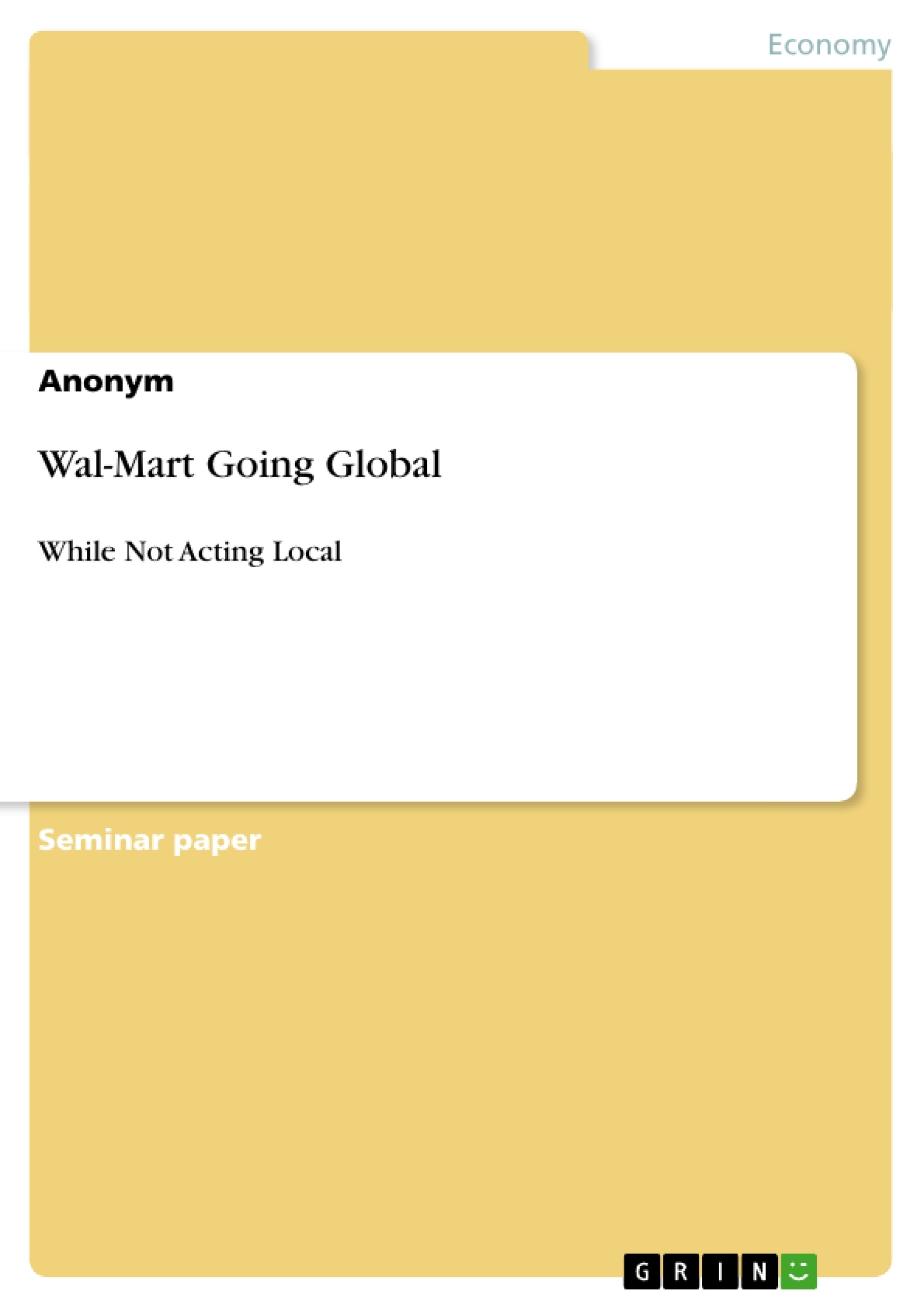Excerpt
Table of Contents
1. Introduction
2. Globalisation – A Theoretical Overview
2.1. The Reasoning of Going Global
2.2. The CAGE Theory
3. General Impacts of Globalisation on Wal-Mart
4. Wal-Mart Operating in Germany
5. Conclusion and Future Strategies
6. Bibliography 19
1. Introduction
With Wal-Mart being one of the biggest retailers in the world, serving customers in more than 8,650 retail units in 15 countries, as stated by the company (Wal-Mart, 2010), it makes the perfect example to look at in terms of globalisation and the impacts and strategies that relate to it. A very brief explanation by Holm and Sørensen (1995, p. 12) defines globalisation as “The intensification of economic, political, social and cultural relations across borders”. In my opinion this phrase is too superficial to actually explain all the outcomes and interrelations of the complexity of globalisation. It is also unknown regarding how to measure the degree on relations across the world and also their intensification as well as whether relationships exist between the economic, political, social and cultural relations. I believe that a definition should also be addressed about the technological and financial transformation that is currently taking place, the geographical reallocation of production and the emerging of a „powerless nation state“.
Others see the phenomena of globalisation rather simple. Levitt (2006, p. 133) stated that “The world’s needs and desires have been irrevocably homogenised”, which leads one to believe that consumer tastes around the world appear to merge. While this is also referred to as the ‘simultaneous theory of internationalisation’, it means that standardised products, services and strategies can be used around the globe.
Keeping in mind of Levitt’s thesis, this paper first gives a general overview of the impacts of globalisation on Wal-Mart as this is important to understand ongoing argumentation. Later, it will concentrate on Wal-Mart’s presence in Germany, explaining the market entry into the country while concurrently focusing on strategies used and outcomes of the company’s actions in Germany.
2. Globalisation – A Theoretical Overview
The most obvious impact of globalisation is the rapid growth in world trade. Sam Walton, the founder of Wal-Mart, opened up the first store 1962 in Rogers, Arkansas. After opening additional stores outside the state in Oklahoma and Missouri, Wal-Mart was officially incorporated as Wal-Mart Stores Inc. on October 31, 1969. Rapid expansion started in the 1970’s by first settling in Kansas, Louisiana, Kentucky, Mississippi, Texas and Alabama. Since 1970 Wal-Mart is a publicly-held company. During the 1980’s states such as Georgia, South Carolina, Nebraska, Florida, Indiana, Iowa, New Mexico, North Carolina, Virginia, Wisconsin, Colorado and Minnesota became part of the company’s portfolio. After continuously expanding within the United States, Wal-Mart first stepped into international spotlight in 1991 by opening a unit in Mexico followed a year later by Puerto Rico. Soon countries like Canada (1994), Hong Kong (1994), Argentina (1995), Brazil (1995), China (1996), Germany (1998), South Korea (1998), the United Kingdom (1999), Japan (2002), Nicaragua, Honduras, Costa Rica, Guatemala, El Salvador (all 2005), India (2007) and Chile (2009) were entered as well (Wal-Mart, History, 2010).
illustration not visible in this excerpt
At present, Wal-Mart has 4,263 international units and 3,780 national units. The company succeeded in global competition and was able to expand its representation in the world. The only problems occurred in Germany and South Korea. Nevertheless, Wal-Mart is number one in the global retailer ranking of 2008 placed before Carrefour, Metro and Tesco.
illustration not visible in this excerpt
Source: Economic Concentration of top 10 retailers, 2008. Retrieved October 16, 2010 from http://www.stores.org/pdf/Top%20250%20list%20for%20web.pdf
This information clearly shows how Wal-Mart has profited from the growth in world trade. It was able to ‘globalise’ with thousands of retail units abroad and also maximize profits through reaching more customers and expanding into new markets. This has surely been a huge benefit for the company, which can now be called a ‘global player’.
2.1. The Reasoning of Going Global
Reasons for investing abroad probably arose from strategic issues as Wal-Mart wanted to match rivals like Metro or Carrefour. Another motivation must have been market seeking meaning the lure of additional revenue and profit from new markets. Concerning Wal-Mart’s strategy, this paper distinguishes on a level of international business between a Global, Transnational, International and a Multidomestic strategy (Table 3). Since the company has low cost competitiveness and low local responsiveness pressures, they are seeking an International strategy. The Head office in Bentonville, Arkansas manages product strategy and marketing initiatives and all core competencies are transferred to the foreign markets. However, they are less responsive to local conditions and learn less from global interactions, which are major mistakes that were later discovered by the company. (Wall, et al., 2010, pp. 255-258)
[...]
- Quote paper
- Anonymous, 2010, Wal-Mart Going Global, Munich, GRIN Verlag, https://www.grin.com/document/214009
Publish now - it's free






















Comments